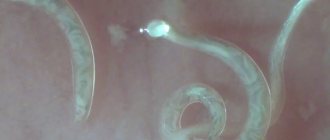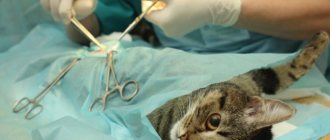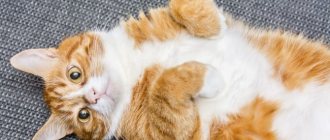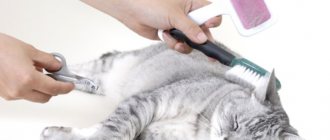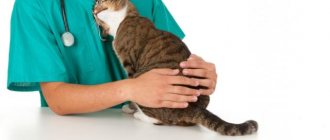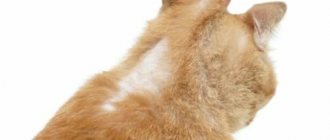False pregnancy in cats (imaginary pregnancy, pseudopregnancy) is a specific condition that occurs against the background of hormonal changes in the body of animals in which a non-pregnant cat exhibits all the signs of a real pregnancy.
Despite the fact that pseudopregnancy is more common in dogs, veterinarians are increasingly diagnosing “false pregnancy” in domestic cats. Therefore, owners should know the causes, symptoms of imaginary pregnancy, how it is dangerous for the cat, as well as what to do and how to help their furry pet survive this condition.
Causes of false pregnancy in cats
False pregnancy in a cat is a neuropsychological disorder that leads to the fact that an unfertilized cat exhibits all the signs characteristic of a pregnant female.
In fact, pseudopregnancy in females is a purely psychological process of a neurotic nature. Even if the cat did not have contact with the male, fertilization did not occur, the animal experiences real symptoms of pregnancy due to the active production of the hormones estrogen and prolactin. They are the ones responsible for the condition and behavior of the female during pregnancy.
Unlike dogs, in which the development of pseudo-pregnancy is inherent in nature in order to maintain the size of the pack, this behavior is not typical for cats. Cats are territorial animals that live on their own without forming large groups. In addition, cats in most cases do not accept other people's cubs and can even kill them. Therefore, the body of females is “insured” from the appearance of “false insects”. The corpus luteum is formed only after mating; if fertilization does not occur, it quickly regresses.
But still, felinologists agree that an imaginary pregnancy is inherent in nature and is a protective mechanism that is aimed at ensuring that the female can take care of and feed kittens born from another cat if, for example, she dies.
Since false pregnancy is relatively rare in cats, if your cat suffers from this condition, it is an indication that something is wrong in her body.
The main causes of false pregnancy in a cat:
- mating with a sterile, castrated male;
- gynecological pathologies, reproductive disorders;
- endocrine diseases (obesity, diabetes);
- physical inactivity;
- unbalanced diet, overfeeding;
- breed, genetic predisposition;
- frequent stress, psychological, emotional stress;
- nervous disorders, central nervous system diseases;
- systemic, congenital, chronic pathologies, diseases;
- inflammatory processes in the organs of the genitourinary tract.
If a cat has mated with a sterile male, hormones send a signal to the brain that the body is ready to carry embryos and give birth to offspring. But since fertilization has not occurred, an imaginary pregnancy develops.
Pseudopregnancy is most often diagnosed in females with congenital pathologies, diseases of the reproductive organs, and endocrine system. Systemic, hidden diseases caused by viruses, bacteria, and endoparasites can also lead to the development of a “false dog” in a furry pet.
Imaginary pregnancy often develops in cats when kept in a group, especially if there are pregnant females or cats with offspring next to a nulliparous cat. Despite the fact that cats, unlike members of the canine family, do not live in packs, domestication and disruption of natural habitat conditions provoke the development of imaginary pregnancy. Subconsciously, the animal “envyes” cats that have and care for offspring, so the psyche begins to simulate a similar state.
Frequent stressful conditions, for example, a change of place of residence, long-term separation from their owners, can also lead to emotional, physiological, hormonal imbalance, against the background of which “falsehood” develops in animals. Therefore, the psychosomatic state of the cat largely determines whether or not an imaginary pregnancy occurs in the female.
Polycystic disease, neoplasms in the genitourinary tract, and frequent mating can also provoke an imaginary pregnancy in a cat.
False pregnancy can develop in fertile cats at any age, regardless of their breed. However, experts have determined that some breeds are more predisposed to developing “false dog”. Thus, a similar condition is most often detected in Oriental cats, Rexes, Britons, Sphynxes, Siamese and their crosses.
Causes of the condition
The presence of diabetes in an animal contributes to the development of this condition. In dogs, imaginary pregnancy develops more often than in cats due to differences in the reproductive cycle. Lifestyle also influences the development of the condition. Cats love solitude and prefer to take care only of themselves, and dogs are pack animals, so if the mother dies, a dog with a phantom pregnancy can feed someone else’s offspring. False pregnancy often occurs after sterilization, when the body’s production of hormones increases. The imaginary condition occurs in domestic cats if the following provoking factors are present:
- disruption of the production of thyroid hormones;
- ovarian neoplasms;
- inflammation of the endometrium of the uterus;
- uterine tumors;
- sexual intercourse with a castrated cat;
- stressful situations;
- age-related changes resulting in hormonal imbalance;
- examination of the internal genital organs using a smear test;
- observation of a non-pregnant cat of individuals bearing offspring;
- diabetes.
Symptoms and how to independently distinguish a false pregnancy from a real one
How to distinguish a false pregnancy from a real one? From a physiological point of view, it is quite difficult to determine on your own whether your pet is pregnant, since the symptoms are practically no different from those of a real pregnancy.
Symptoms of pseudopregnancy in a cat:
- changes in taste preferences, unstable appetite;
- increased thirst;
- inadequate response to stimuli;
- restless behavior;
- demanding loud meowing;
- increase in abdomen, body weight;
- frequent urination;
- disorder in the functioning of the gastrointestinal tract (vomiting, mucous diarrhea);
- lethargy, drowsiness;
- swelling of the nipples;
- lactation (release of milk from milk bags);
- discharge of colorless mucous viscous secretion from the genital tract;
- unstable temperature.
Important! Imaginary pregnancy in cats occurs four to six weeks after the end of estrus or mating with a cat.
The signs and intensity of symptoms of false pregnancy in a cat largely depend on the conditions of detention, the psycho-emotional state of the female, the type of nervous system, and hormonal levels. In some individuals, the symptoms are clearly expressed, in others the “spoon” occurs almost unnoticed, with the exception of minor changes in habitual behavior.
With an imaginary pregnancy, the cat either becomes overly affectionate, constantly demands attention, literally follows on the heels of its owners, or, conversely, becomes agitated and restless. The affectionate kitty is reluctant to make contact with a person, secluded in secluded places in the house or apartment. Some females begin to set up a maternity “nest” and most often do this in closets, on an armchair, sofas, or choose other quiet places.
If a pet has a strongly developed maternal instinct, she can show care for soft toys and household items (slippers, scarves, gloves), mistaking them for her “cubs.” The cat carries toys in its teeth, constantly carries them to secluded places and can even show aggression if there is excessive attention to its imaginary “offspring”.
The main sign of an imaginary pregnancy is an enlarged abdomen, swollen nipples, lactation (milk leakage from milk bags). When you press on the nipple, colostrum, a white cheesy mass, appears in a small amount.
You may notice that the cat refuses active outdoor games. Movements are sharp and careful. The pet pays more attention to its hygiene, constantly licks the external genitalia, and licks off the discharge.
Cats may exhibit toxicosis, especially during mid-spoon development. If at the beginning of the development of this condition the appetite is increased, after a few days due to nausea and vomiting the pet refuses food and the offered treats. In the vomit you can see particles of undigested food and feed. Some individuals have a perverted appetite. The animal eats or shows interest in inedible objects.
Important! During a false pregnancy, a cat’s body temperature is unstable and most often increased by 1-1.5 degrees.
It is possible to determine 100% whether a false pregnancy has occurred in a cat only in a veterinary clinic after carrying out all the necessary diagnostic examinations. The veterinarian takes into account medical history and ultrasound results.
If the cat has been bred, but you doubt whether fertilization has occurred, we recommend that you bring the animal to the clinic two to three weeks after mating.
How long does a false pregnancy last in a cat?
The duration of imaginary pregnancy in cats is individual for each individual. On average, this condition can last from three to five weeks or more. Much depends on the root cause, the emotional state of the cat, and the strength of the maternal instinct.
Female reproductive cycle
The female reproductive cycle consists of four periods:
- Proestrum is the initial period of estrus. Duration: one to two weeks. Manifested by the presence of bloody discharge from the vagina, hyperemia of the vulva. At this time, follicles mature in the ovaries, releasing the hormones estrone and estradiol into the blood. Under the influence of estrogens, hyperplasia of the uterine tissue begins, preparing them for implantation of embryos.
- Estrus is hunting. Duration: one to two weeks. Characterized by strong sexual arousal of the female. The discharge brightens, becomes mucous, ovulation occurs - the opening of mature follicles and the release of eggs (oocytes).
- Metoestrum is the end of estrus. Duration: one to two months. Sexual arousal disappears, the loop decreases to normal size. The follicles, under the influence of gonadotropin, turn into corpus luteum, producing progesterone. Unfertilized eggs are destroyed, fertilized eggs develop - pregnancy begins.
- Anestrum is a period of rest. Duration: three to four months. In the absence of fertilization, the corpus luteum atrophies, progesterone production decreases, and follicle maturation resumes.
Why is an imaginary pregnancy dangerous for a female?
Many owners of furry purrs believe that the “spoon” will go away on its own. But this is clearly a fallacy. During this period, the pet needs care, attention, and some care more than ever. It is possible that the “spoon” occurred due to lack of attention, rude attitude, or improper care.
Advice! It is necessary to normalize the female’s condition as quickly as possible. Otherwise, not only the nervous system will suffer, but also serious complications and pathologies will develop.
Pseudopregnancy leads to the development of:
- mastitis.
- pyometra (purulent inflammation of the uterus);
- endometritis;
- infertility;
- severe nervous psychological disorders.
The owner must do everything necessary to eliminate the symptoms and manifestations of an imaginary pregnancy. Diseases of the genitourinary and reproductive tract are accompanied by acute inflammation, which becomes chronic. Develops due to hormonal and endocrine disruptions, increased blood supply to the uterus and internal genital organs.
In severe cases, inflammation leads to sepsis and acute intoxication, which can cause death in the absence of emergency qualified treatment.
Mastitis during false pregnancy in a cat
Excessive secretion of milk provokes mastitis - inflammation, suppuration of the mammary glands. Sex hormones, in particular prolactin, which are produced during pregnancy and immediately after childbirth, are responsible for the production of milk.
If the inflammation progresses to an advanced form, the animal needs long-term therapy. Mastitis provokes breast cancer, which will entail their removal. Therefore, first of all, it is necessary to do everything to stop lactation and reduce the body’s milk production.
Possible complications
The state of pseudopregnancy in itself is not scary for an animal. The danger is caused by serious complications, which in severe and advanced cases can lead to the death of the pet.
Mastitis
The production of milk in a mother who is going to feed her offspring is quite physiological. But the birth of kittens is not expected, and lactation has started, producing empty milk that does not go anywhere. If you do nothing to help the mammary glands avoid stagnation, then you are not far from mastitis - an infectious-inflammatory, often purulent process. It must be treated with antibiotics, and in difficult cases, a unilateral or bilateral mastectomy (removal of the entire strip of mammary glands) can be performed.
Pyometra
Pseudopregnancy can also cause a disease such as pyometra - inflammation of the uterus with the accumulation of purulent contents in it. Conservative drug treatment is possible only in the initial stage of the disease, but most often, in order to save the animal’s life, surgical removal of the uterus and ovaries is performed.
Severe psychological condition
Often the psychoneurotic reaction of the central nervous system depresses imaginary expectant mothers and causes serious mental disorders that can be dangerous for people. Murki can seriously protect their newly-made “children” from attacks, rush at their owners, scratch and bite. They are able to turn their anger on the home environment, causing serious damage to furniture, wallpaper and other surfaces in the house. Such furies must be prescribed sedative therapy, and you should not wait 2-3 weeks and hope that everything will go away on its own.
What to do and how to calm your cat
Unlike dogs, for which false pregnancy is a natural physiological process, pseudo-pregnancy for a cat can be called a serious disorder and pathology. What to do and how to calm a cat? How to help your pet overcome this condition?
Important! If you notice signs of “spooning”, we recommend contacting your veterinarian. You may need conservative drug treatment, which the veterinarian will prescribe, taking into account the individual characteristics of your pet’s body.
To help your cat recover faster and get out of this state, provide her with the most comfortable living conditions and proper care. Do not scold or punish the animal under any circumstances, since the female cannot control her natural urges.
First of all, review your diet. Reduce portions slightly, completely exclude fermented milk, dairy products, as well as protein-rich foods. Food during this period should be easily digestible and not too high in calories. If your cat is kept on a prepared diet, choose products labeled “light”.
To reduce milk secretion, reduce the amount of water and fluid intake. Eliminate wet food, broth-based cereals, and soups from your diet. You can give your cat water no more than three times a day; give water in small portions.
Remove toys and personal items that the cat mistakes for its “cubs.” Surround your pet with attention, affection, and care. Play with your pussy to distract her from caring about her imaginary “offspring.”
Make sure your cat doesn't lick your nipples. Tactile stimulation enhances lactation. Don't express milk. Put a blanket and an Elizabethan protective collar on the cat. Do not use bandages that are too tight, as this may lead to mastitis.
Diagnostics
You will need to provide details about your dog's health and the occurrence and nature of symptoms. Your veterinarian will perform a thorough physical exam to evaluate all of your dog's body systems and overall health. Routine blood tests will include a complete blood count, biochemical profile, and urinalysis, which usually show normal results unless there is an underlying disease.
And imaging tests, such as abdominal x-rays and ultrasounds, are used to rule out uterine infection or a normal pregnancy.
Treatment, drugs
In severe cases, if an imaginary pregnancy has developed against the background of endocrine and hormonal changes, a veterinarian should provide assistance to the animal. Cats are prescribed sedatives to normalize their emotional state (Cat-Bayun, Fitex, Anti-stress), and decoctions of medicinal herbs (motherwort, chamomile, sage).
Hormone therapy is being carried out. Naloxone and Cyclozocin are administered orally twice a day. The dose is calculated based on the pet’s weight (0.01 mg per kg of body weight), but it is still better if the dosage is prescribed by a veterinarian. The drug “Galastop” (solution for oral use) helps well with “spooning”.
For endocrine and other pathologies, symptomatic therapy and homeopathic medicines are used. For inflammation of the uterus - antibacterial agents. If mastitis has developed - ointments, gels that have anti-inflammatory, analgesic, antibacterial, decongestant effects, drugs that block the activity of prolactin. The preparations are lubricated two to three times a day on the cat’s mammary glands.
Treatment is carried out until the cat’s condition is completely normalized and all symptoms of an imaginary pregnancy are eliminated.
Veterinarian help
When you bring your pet to the veterinary clinic, she will be given an examination and tests. If the fears are confirmed, the doctor may prescribe:
- Sedatives to correct behavior and calm the cat.
- The preparations will be herbal based, so there is no need to worry too much.
- Also a special solution that helps stop lactation.
- To maintain normal well-being and proper functioning of the body, vitamins and minerals will be prescribed.
- Moreover, the animal’s body will be exhausted and it urgently needs replenishment in such cases.
In addition to these medications, special hormonal therapy will be prescribed, which will be divided into an individual treatment regimen. If mastitis begins during a false pregnancy, then the cat will need to be given medicinal decoctions and antibiotics.
In addition, it will be tedious to massage the mammary glands. Treatment will last as long as needed. Until all symptoms go away.
Prevention of false pregnancy in cats
Considering that the “spoon” depletes the body of females not only physically, but also mentally, it is very important to prevent such a condition. Pay more attention to the cat, interest your pet in active games.
Think about your nutrition. The diet should be balanced, varied, and fortified. Watch the amount of protein foods.
Prevention of imaginary pregnancy involves creating the most comfortable living conditions. Protect your kitty from unnecessary stress and emotional turmoil.
Choose partners for your cat if you plan to breed or breed her. Do not allow infertile, sick, sterile cats to breed. You cannot breed a cat during the last days of her heat.
If your cat has a genetic tendency to develop a false pregnancy, take her to the clinic at least once a year for hormone tests. Do not use drugs to stop sexual hunting or rutting.
If pseudopregnancy with obvious symptoms occurs in a cat after each heat, the animal is of no breeding value, it is best to sterilize it. The operation will prevent the development of pathologies and diseases of the reproductive system.
Prevention
To prevent the development of dangerous diseases of the reproductive system and psyche of your pet, you should take into account a number of tips from veterinarians:
- It is best to breed a cat only to a cat that has a good “reproductive reputation.” You need to select for mating a male that has repeatedly produced healthy offspring;
Mating should be carried out only with proven males
- You should not keep a pet together with a cat that already has offspring. An “example” in the form of a female with kittens can affect the psyche of an animal without newborns;
- If after several matings the cat does not produce offspring, you need to show it to the veterinarian. Often unsuccessful matings indicate the presence of diseases in the female’s body, or a series of miscarriages that occurred in the early stages of pregnancy.
Unsuccessful matings are a good reason to have your cat examined by a veterinarian
Attention! The pet must also be protected from stress. You should not keep him near hostile animals, deprive him of attention, etc.
